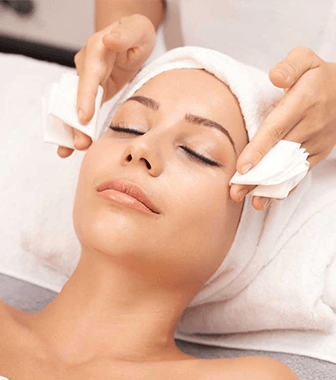Simply put: Exfoliating is when you get rid of dead skin cells on the surface of your skin. You can do this chemically or physically.
Home Chemical Peels - Which Is Best For You?
Cleansing and sun protection are absolute essentials in any skincare routine. However, exfoliating is also crucial. Regular exfoliation improves skin texture, tone, and enhances the effectiveness of other skincare products.
Alpha-hydroxy acids (AHAs): water-soluble acids work their magic by gently loosening the upper layers of your skin, creating a peeling effect. This powerful action helps fade pigmented spots and smooth out rough or bumpy patches for a more even complexion.
Beta-hydroxy acids (BHAs): oil-soluble acids are like superheroes for your pores. They dive deep beneath the surface to tackle excess debris and sebum buildup.
AHA/BHA blends: a streamlined exfoliation option that combines acids in one formula for multitasking benefits.
What Exactly is a Chemical Peel and How Does It Work?
Home-based chemical peels act as surface-level exfoliants, either gently or more intensely clearing away dead skin cells and surface-level impurities from the skin, specifically the epidermis, which is a primary determinant of skin tone.
Peels that penetrate deeper than the epidermis are effective in reducing noticeable skin concerns that originate deeper within the skin layers, like wrinkles and scars, or blocked hair follicles and sweat glands, which often lead to severe forms of acne.
With the right selection, chemical peels can enhance your skin's texture and tone, improving the appearance of pores, fine lines, wrinkles, scars, and discoloration. Home chemical peels can make your skin appear younger and more radiant.
Certain chemical peels merely exfoliate without causing noticeable peeling (superficial, light peels), while others result in varying degrees of peeling (medium, deep), depending on your skin's characteristics, the peel's intensity, and the type of peel used.
Getting Started with Home-Based Chemical Peels
Chemical peels are effective for anti-aging benefits, addressing acne and its scars, reducing pores, removing blackheads, reviving sun-damaged skin, enhancing the look of stretch marks, diminishing age spots, and addressing overall hyperpigmentation. They also serve to refresh and improve your skin's tone and texture.
Performing a chemical peel at home is a simple, convenient, and cost-effective method of self-care. After all, your face is singular and deserves proper attention. The most effective home chemical peel is the one that directly addresses your unique concern.
Below, you'll find a guide designed to further illuminate the world of chemical peels. Explore all our peels and identify the ones that target your specific issues best.
Alpha Hydroxy Acid Peels
MANDELIC ACID
An alpha hydroxy acid extracted from the bitter almond nut, Mandelic Acid is a mild acid owing to its large molecular structure. It exfoliates the skin with minimal topical discomfort and is particularly effective in curbing the development of brown spots and hyperpigmentation.
This gentle acid will not cause unwanted lightening of the skin in clients with darker skin tones. It enhances acne, melasma, sun-damaged skin, enlarged pores, blackheads, wrinkles, and lackluster, sallow skin. A 25% Mandelic Acid peel will result in little-to-no peeling, while a 40% concentration may lead to mild flaking for the majority of clients. Contraindications: Avoid usage if you have nut allergies.
LACTIC ACID
Less intense than glycolic acid and generally more proficient at addressing discoloration, our formulation includes licorice extract, a potent skin-lightening ingredient. Suitable for both dry and oily skin, this alpha hydroxy acid makes an excellent "starter peel" for oily, dry, normal, and sensitive skin types.
Intrinsic characteristics of this peel make it ideal for individuals with uneven skin tones and broad hyperpigmentation. Light flaking is common, and becomes more noticeable as the peel's strength is increased. Contraindications: Avoid usage if you have milk allergies.
GLYCOLIC ACID
A bit more potent than lactic acids, this alpha hydroxy peel effectively exfoliates the outer layers of your skin. Glycolic acid serves as a versatile acid for normal to oily skin types, facilitating skin exfoliation and rejuvenation, and tackling acne, acne scars, wrinkles, and fine lines. A 30% concentration typically prompts rapid skin exfoliation with minimal visible peeling or flaking. However, stronger glycolic acid peels may induce some flaking. The intensity of the glycolic acid peel directly correlates with the amount of flaking or peeling you may experience.
Beta Hydroxy Acid Peels
SALICYLIC ACID
Being oil-soluble, these acids are ideal for oily or acne-prone skin that requires deep pore cleansing and blackhead loosening. Use this as a "preliminary step" when using alpha hydroxy acid peels to strip oils from the skin, or utilize independently 3-4 times weekly for oil and blackhead management. As a beta-hydroxy acid, it infiltrates only the upper strata of the epidermis. For a more potent application, use our 15% salicylic acid peel once a week. Contraindications: Avoid use if allergic to aspirin products.
PRECAUTIONS
SAFE HANDLING OF ACID PEELS AND RETINOIDS:
- Use Acids and Retinoids with extreme care and caution.
- Always perform a patch test prior to application.
- Avoid contact with eyes and mucous membranes.
- In case an acid/retinoid enters the eyes, rinse with cool water and seek medical advice.
- Keep these products out of reach of children.
- Misuse of chemical products can lead to burns or injury. Use as directed.
- Always store chemical peels in a cool, dry place for a 12-month shelf life.

